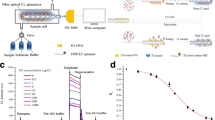Abstract
The ubiquitous presence of chemicals, both natural andsynthetic, in the environment with the potential to mimichormones that may in turn interfere with the endocrinesystem in both wildlife and humans has in the last decadebecome a major international concern. Hormone mimics orendocrine disrupting compounds (EDCs) are especiallyprevalent in surface and waste-waters and therefore, thereis a need for an at-source or at-line analytical device forthe monitoring of EDC levels.We have incorporated a miniature integrated surface plasmonresonance (SPR) liquid sensor from Texas Instruments into afield analyser and developed a competition/inhibition assayfor a model estrogenic compound in aqueous samples. Theanalyser has the potential for in situ and semi-continuous analysis of EDCs. A novel regeneration schemeemploying the use of a domestic laundry detergent has beenused to remove immobilised assay components between eachassay cycle. The resultant re-usable sensor has beendemonstrated using estrone-3-glucuronide (E3G) as a modelEDC and an anti-E3G antibody producing a current detectionrange of 10 to 150 ng mL-1.
Similar content being viewed by others
References
Arnold, S. F. and McLachlan, J. A.: 1996, ‘Synergistic signals in the environment’, Environ. Health Perspect. 104, 1020–1023.
Elkind, J. L., Stimpson, D. I., Strong, A. A., Bartholomew, D. U. and Melendez, J. L.: 1999, ‘Integrated analytical sensors: the use of the TISPR-1 as a biosensor’, Sens. Actuators B54, 182–190.
Kukanskis, K., Elkind, J., Melendez, J., Murphy, T., Miller, G. and Garner, H.: 1999, ‘Detection of DNA hybridization using the TISPR-1 surface plasmon resonance biosensor’, Anal. Biochem. 274, 7–17.
U.S. Environmental Protection Agency: 1997, ‘Special report on environmental endocrine disruption: An effects assessment and analysis’, EPA Report EPA/630/R-96/012, 11–17.
Seifert, M., Haindl, S. and Hock, B.: 1999, ‘Development of an enzyme linked receptor assay (ELRA) for estrogens and xenoestrogens’, Anal. Chim. Acta 386, 191–199.
Woodbury, R. G., Wendin, C., Clendenning, J., Melendez, J., Elkind, J., Bartholomew, D., Brown, S. and Furlong, C. E.: 1998, ‘Construction of biosensors using a gold-binding polypeptide and a miniature integrated surface plasmon resonance sensor’, Biosens. Bioelectron. 13, 1117–1126.
Author information
Authors and Affiliations
Corresponding author
Rights and permissions
About this article
Cite this article
Sesay, A.M., Cullen, D.C. Detection of Hormone Mimics in Water using a Miniturised SPR Sensor. Environ Monit Assess 70, 83–92 (2001). https://doi.org/10.1023/A:1010673030313
Issue Date:
DOI: https://doi.org/10.1023/A:1010673030313




